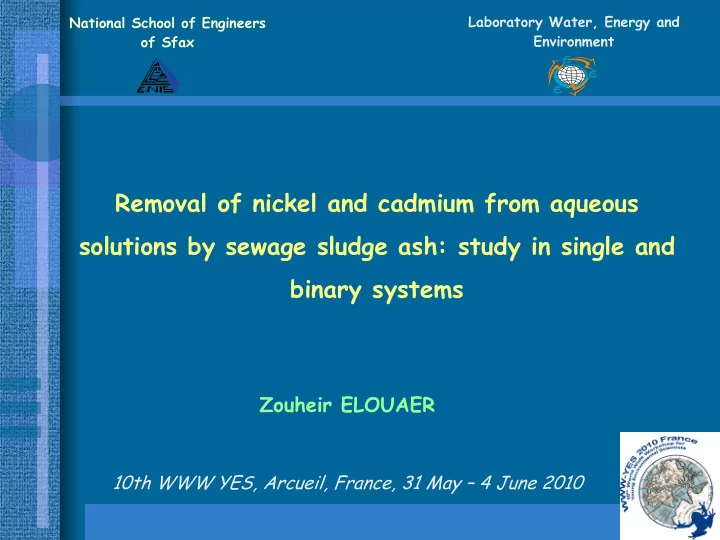

Laboratory Water, Energy and National School of Engineers Environment of Sfax Removal of nickel and cadmium from aqueous solutions by sewage sludge ash: study in single and binary systems Zouheir ELOUAER 10th WWW YES, Arcueil, France, 31 May – 4 June 2010
Outlines I. Introduction II. Material and methods III. Results and discussion IV. Conclusion 2/12
Overview of Heavy Metals A metal having a density greater than 5 g/cm 3 Some notion of toxicity Non Essential Elements Essential Elements ( low [ ]) = Cd, Pb, Hg, Sn,… (Micronutrients ) = Fe, Zn, Ni, Cu, Mn,…. • Have not known biological function • Essential for cellular functions • Toxic at lower[ ] than essential elements Toxic from a certain threshold 3/12
Treatment process of heavy metals wastewater In the case of wastewater, several treatments process : � Membrane processes � ion exchange � précipitation and co-précipitation � adsorption (sludge ash, phosphate rock, activated carbon, iron oxide,...) 4/12
Adsorption ? Adsorption is a physicochemical phenomenon resulting in a change in concentration at the interface of two immiscible phases, namely solid / liquid. Sorption is interesting: Sorbent � Fixed systems � Porous materials � simple technique � A high specific surface area � Feasible regeneration � Regenerable � Stable waste 5/12
Material and methods Preparation Characterization X-ray Chemical Drying Sludge cake at 105 ° C diffraction analysis Burning samples at 600 ° C for 2hours Sludge ash Sieving and collection of the fraction < 100µm Infrared Scanning Electron spectrophotometer Microscopy 6/12
Material and methods The methodology of batch study: � Contact time necessary to get equilibrium � The influence of pH on the sorption of Cd and Ni � Effect of temperature on the sorption � Establishment of sorption isotherms � Effect of competition between different pollutants 7/12
Results and discussion Characterizations of the sorbent Chemical composition Rich in silica (20%) and in alumina (10%) (sorption function ) and in Ca oxide (20%) and K (4-23%) 2 μ m SS: 51 m 2 /g Porous structure Figure. Scanning electron micrograph of sewage sludge ash. 8/12
Results and discussion pH effect Kinetic study Ni Cd Ni Cd 8 8 7 6 6 q e(m g /g ) q e (mg/g) 5 4 4 3 2 2 1 0 0 0 2 4 6 8 10 0 100 200 300 400 pH Time (min) The maximum sorption of The optimum time for both Cd Ni and Cd was found to and Ni removal was 120 min occur at pH 6 9/12
Results and discussion Sorption isotherms Ni(II) and Cd(II) sorption isotherm on sewage sludge ash at 20 ° C 10/12
Results and discussion Langmuir and Freundlich constant for Ni(II) and Cd(II) sorption in single system Langmuir model Freundlich model R 2 R 2 q max b K f 1/n (mg/g) (L/mg) Ni (single-metal) 7.65 0.051 0.99 0.87 0.45 0.95 Cd (single-metal) 7.1 0.039 0.98 0.69 0.47 0.93 11/12
Conclusion The results obtained in this study clearly demonstrated the potential use of sewage sludge ash for the removal of Ni(II) and Cd(II) from aqueous solutions. � The kinetic studies indicated that equilibrium was reached in 2 h � The optimum pH corresponding to the maximum adsorption was found to be 6 � The enhanced sorption at higher temperature indicates endothermic sorption process � The affinity of the sewage sludge ash for Ni(II) ions was greater than that for Cd(II), from both single-component and the binary solutions 12/12
Thank you for your attention
Recommend
More recommend